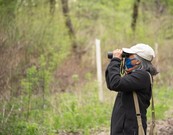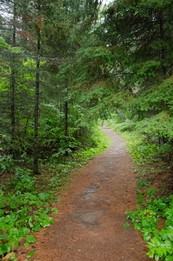|
Volume 9 - July 2022
Nature and Public Health
Summer in Minnesota has arrived! The days are long, the sun is warm and our surroundings are vibrant, encouraging Minnesotans to enjoy the beautiful outdoors. But these aren't the only reasons to explore the nature around you. This month's edition of the Reader highlights the positive effects of nature on public health. The past two years of the global pandemic has illuminated the importance of the outdoors for physical and mental well-being, and there are vast amounts of research and initiatives to support that right here in Minnesota. All of our state parks are now listed in the Park Rx America Model, where doctors can prescribe venturing out in nature to a patient. This model is also being embraced at the local level, and the Southeast Minnesota Park Rx collaborates with Mayo Clinic to match the needs of patients with local and regional state parks. The Minnesota Department of Natural Resources is also offering guided Forest Bathing experiences, where submersing yourself in the beautiful forests of our state can help relieve stress and improve physical and mental health. And the benefits of the outdoors are not just limited to parks and forests: Blue mind science speaks to the positive cognitive and physical effects of water, including research that states boating and recreational fishing improve creativity, emotional health and relaxation.
We hope you enjoy the articles below that support the importance of the outdoors and natural resources on human health and well-being. For now, take a deep breath and get out in nature to soak in the calm, beauty and restorative medicine of our state’s parks, forests and lakes.
---
The Minnesota Research Reader is a collaboration between the Minnesota Department of Natural Resources and the U.S. Department of Agriculture Forest Service that provides a quick look at emerging research relevant to our work in the State of Minnesota. We hope you enjoy the selection of articles in this month's edition of the Reader!

This article, hot off the press from the University of Minnesota, examined the role of parks and nature to support well-being during the COVID-19 pandemic. The study quantitatively evaluated the associations between the number of neighborhood parks and depression, anxiety and loneliness among older adults; and conducted qualitative thematic analysis of participants’ outdoor experiences.
Management Implications:
- Thematic analysis identified diverse engagement in greenspaces that boosted physical, mental and social well-being.
- The therapeutic potential of outdoor and greenspaces should be considered for interventions during future epidemics or other pressures on humans.
- Future public health and urban planning efforts could focus on creating small-scale outdoor spaces for residents beyond formal parks. Targeted programming such as collective community garden opportunities, gardening tool lending by libraries and senior centers, and birdwatching and photography classes may support physical, mental and social well-being among older adults.
|

This chapter, published by the U.S. Forest Service in the parent publication “Igniting research for outdoor recreation: linking science, policy and action,” explores how the current surge in health response science can inform recreation facilities planning and programming. The authors introduce a number of active nature-for-health initiatives that can be implemented across a variety of landscape gradients. The chapter examines how human health response has often been implicit in recreational plans, while explicit health-centered goal setting may offer new opportunities. It explores human health through an “all lands” outlook and can extend the connectivity of recreational facilities beyond public land boundaries and into partnerships with local governments. It also describes the benefits and contributions of outdoor activity to human health with collaborations and nontraditional partners.
Management Implications:
- Planning and programming across the entire span of nature-based activities, can integrate leisure and lifestyle and include planning for equity, inclusiveness and stewardship.
- The nature and health arena is of increasing interest to the private sector (e.g., outdoor equipment vendors, health care firms and health insurance companies), conservation groups (The Nature Conservancy, Wildlife Society, Trust for Public Land), organizations leading therapeutic programs and local governmental jurisdictions. The shared interests in human health are leading to nontraditional collaborations between public health and public lands professionals.
- Researchers and practitioners might consider elevating goals of human health benefits and outcomes in land planning and management to address the supply, demand, and need for nearby nature. Planning and investment for new parks and open spaces can incorporate strategic land assets and linkages, becoming health interventions where they are most needed across the landscape gradient.
|

This research summary, released from the Forest Service's National Technology and Science Delivery Team in 2018, communicates the broad health benefits of urban trees and green space. The comprehensive review of the current literature describes limitations and opportunities in using scientific knowledge to improve individual and community health. This report summarizes some of the most prominent research related to nature and public health to help urban natural resource professionals, urban planners, architects, educators, health professionals and community groups effectively communicate the health benefits of urban nature to their constituents.
Management Implications:
- The link between nature, health and preventive medicine will hopefully spur more direct collaboration between the health, urban planning, education and natural resource communities.
- This area of research is continuously growing and illuminating the essential role that nature plays in the health and well-being of our minds, bodies and spirit.
- The need to focus on shared interests, goals and objectives across different groups will help managers communicate the benefits of urban nature.
|

International researchers from Sweden, the U.K., Netherlands and Washington State compiled this review of research that provides a framework of understanding how nature can affect public health, including considerations such as air quality, physical activity, social cohesion and stress reduction. They explore topics relevant to planning, design and policy measures; challenges in defining nature and the recent expansion in this field, and evidence that supports (as well as identifies where caution is needed) these benefits in nature.
Management Implications:
- The evidence for some benefits, such as short-term restorative effects, is already quite strong.
- There are demonstrable benefits of green space and recreation space on all of these aspects of human health (air quality, physical activity, social cohesion and stress reduction).
- Explaining how health benefits might coincide (versus conflict) with other benefits, such as better stormwater management, species preservation, and carbon sequestration, still remains a task and future priority with integration in policy and management.
|
|